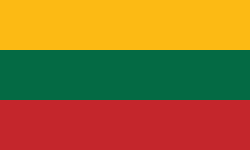Mažeikiai
 |
 |
Mažeikiai was first mentioned in written sources in 1335. A chronicler of the Livonian Order wrote about a campaign of the Order, during which the land of Duke Mažeika was devastated. The town started growing rapidly in 1869 when the Libau–Romny Railway connecting Vilnius and Liepāja was constructed. In 1893, the town had 13 shops and 5 alehouses. In 1894 an Eastern Orthodox church was built, and a synagogue had been founded several years earlier. In 1902 a Catholic church was established, followed by an Evangelical-Lutheran church in 1906. From 1899 to 1918 the town was called Muravyov.
In 1919 Mažeikiai became the county centre and received the rights of self-government. During the first years of independence, Mažeikiai was subject to a territorial dispute between Lithuania and Latvia because of its importance as a railway hub between the Latvian cities of Riga, Jelgava and Liepaja. In 1921 Latvian claims for the town were rejected by an international commission.
A hospital and a library were opened in 1922 and a museum in 1928. In 1939 the population of the town was recorded as 5,618. In 1940 26 industrial companies, 4 banks and a credit union operated in Mažeikiai.
In 1940 the Soviet Union occupied the town and it was annexed to the Soviet Union on 3 August 1940 as a part of the Lithuanian SSR. During World War II, Mažeikiai was under German occupation from 26 June 1941 until 31 October 1944. It was administered as a part of the Generalbezirk Litauen of Reichskommissariat Ostland. In August 1941 a mass killing occurred in which 4,000 Jews from the Mažeikiai district were killed.
In 1950 Mažeikiai became the district centre.
Map - Mažeikiai
Map
Country - Lithuanian_Soviet_Socialist_Republic_(1918–1919)
 |
 |
| Flag of Lithuania | |
Germany had lost World War I and signed the Compiègne Armistice on 11 November 1918. Its military forces then started retreating from the former Ober Ost territories. Two days later, the government of the Soviet Russia renounced the Treaty of Brest-Litovsk, which had assured Lithuania's independence. Soviet forces then launched a westward offensive against Estonia, Latvia, Lithuania, Poland and Ukraine in an effort to spread the global proletarian revolution and replace national independence movements with Soviet republics. Their forces followed retreating German troops and reached Lithuania by the end of December 1918.
Currency / Language
| ISO | Currency | Symbol | Significant figures |
|---|---|---|---|
| EUR | Euro | € | 2 |
| ISO | Language |
|---|---|
| LT | Lithuanian language |
| PL | Polish language |
| RU | Russian language |















